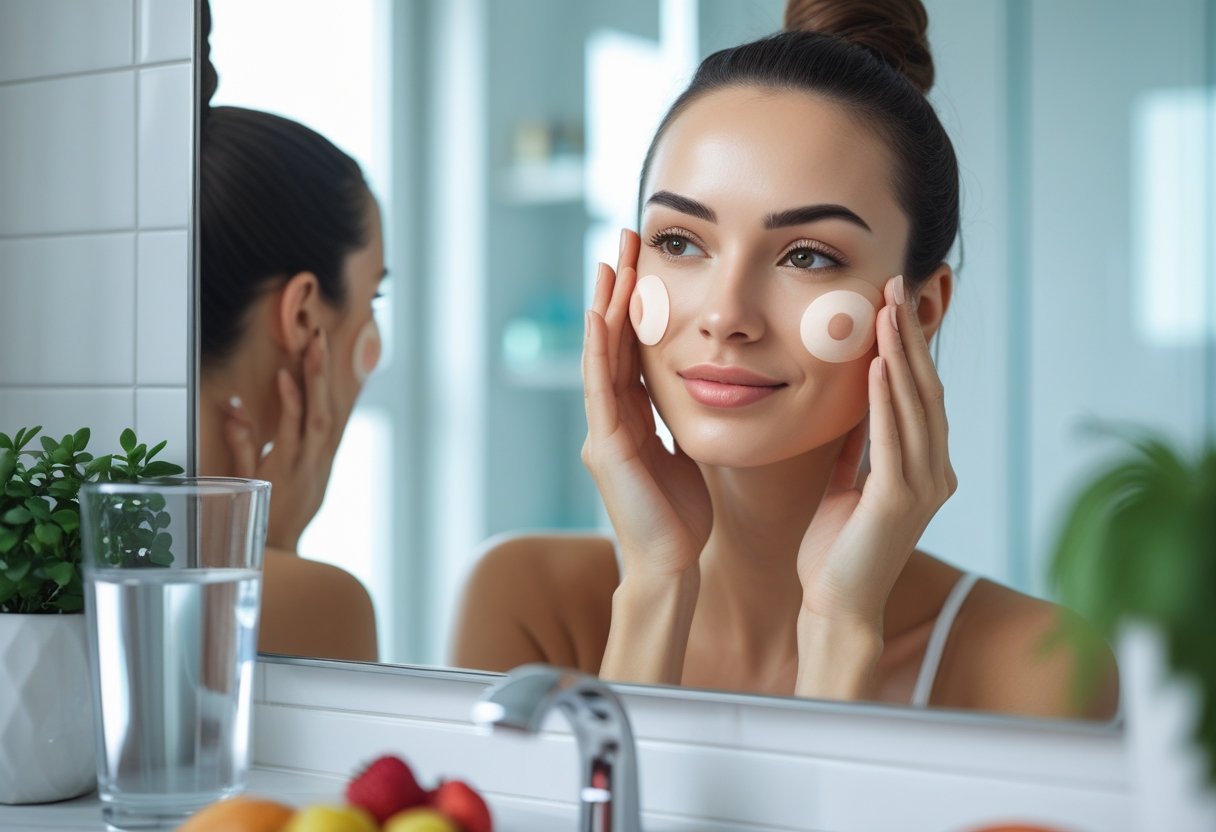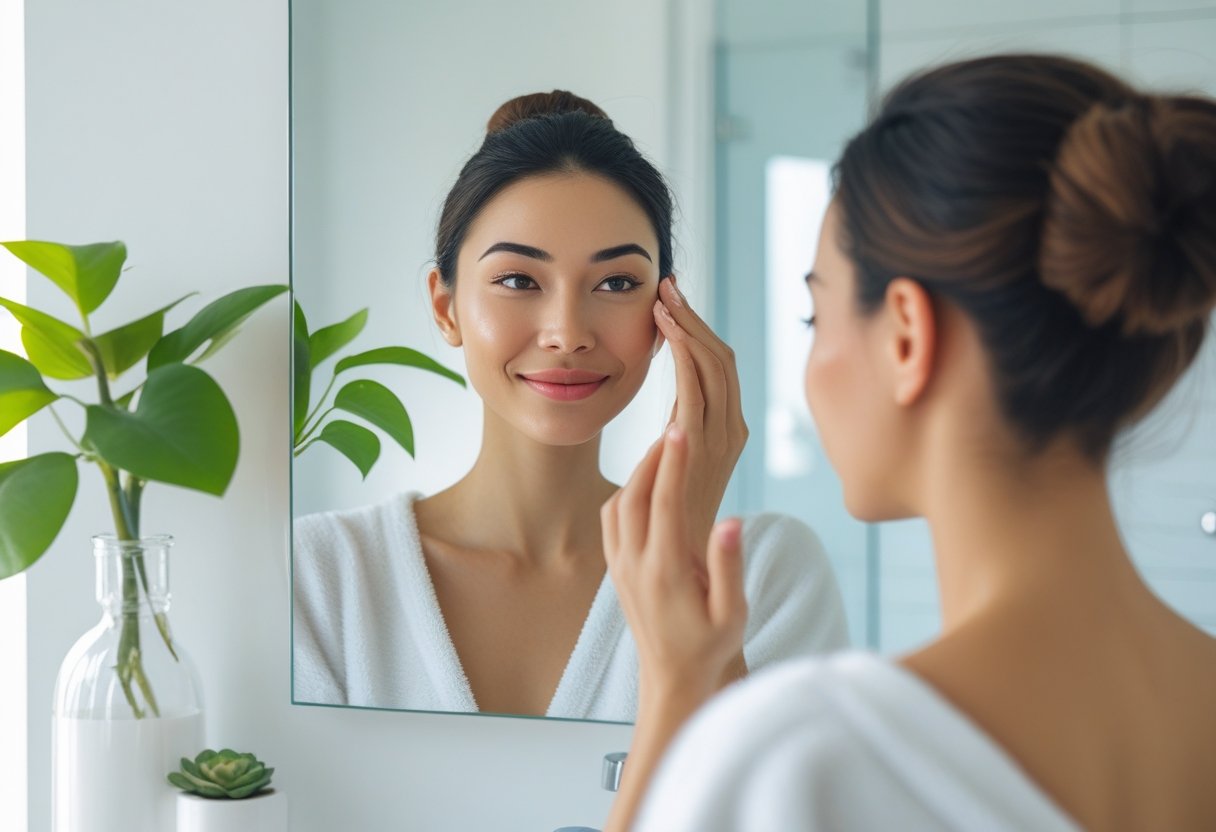A fuller face can make people feel self-conscious and affect their confidence. While it’s not possible to target fat loss in specific areas, losing weight overall can help slim down facial features.

The most effective ways to reduce face fat include maintaining proper hydration, getting enough sleep, limiting alcohol and salt intake, and following a balanced diet combined with regular exercise. These lifestyle changes work together to decrease overall body fat, which naturally leads to a slimmer face.
Facial exercises and proper skincare can help tone the muscles and improve skin appearance, creating a more defined facial structure. A consistent routine of healthy habits delivers the best results for achieving and maintaining facial definition.
Key Takeaways
- Regular exercise and a balanced diet reduce overall body fat, including facial fat
- Staying hydrated and limiting salt intake helps prevent water retention in the face
- Adequate sleep and stress management support healthy weight maintenance and facial appearance
Understanding Face Fat and Its Causes

Facial fat accumulation stems from multiple biological and lifestyle factors that affect how the body stores and distributes fat. Some people naturally carry more fat in their face due to their genes, while others experience changes from hormones, aging, or fluid retention.
Genetic Factors in Facial Fat
Your DNA plays a major role in where your body stores fat. Some people inherit facial features that make their face appear fuller.
Face shape and fat distribution patterns are largely determined by genetic factors passed down from parents.
Body type and bone structure also influence how facial fat appears. People with certain facial bone structures may appear to have more facial fat, even at a healthy weight.
Fat cells in the face respond differently to weight changes based on genetics. Some people lose facial fat easily while others retain it more stubbornly.
How Fat Distribution Affects Facial Appearance
The body stores fat in specific patterns unique to each person. Women typically carry more facial fat than men due to natural hormone differences.
Fat tends to accumulate in key areas like the cheeks, chin, and neck. These deposits can create a rounder face shape.
When gaining weight, some people notice changes in their face first before other body parts. This happens because facial fat cells are more sensitive to weight fluctuations.
Fat distribution changes throughout life as people age and experience hormone shifts.
Water Retention and Facial Puffiness
Excess fluid retention often causes temporary facial swelling. High sodium intake is a common trigger for water retention in the face.
Poor sleep, alcohol consumption, and dehydration can increase facial puffiness. The body often responds by holding onto more water.
Weather changes and allergies may cause the face to appear fuller due to inflammation and fluid buildup.
The Role of Aging and Hormones
As people age, their skin loses elasticity and facial fat pads shift downward. This natural process can make the face appear fuller in certain areas.
Hormonal changes during pregnancy, menopause, and other life stages affect how the body stores facial fat.
Certain medications like corticosteroids can increase facial fat deposits and cause a “moon face” appearance.
Thyroid conditions and other hormone imbalances may contribute to facial fat accumulation or loss.
Sleep patterns and stress levels influence hormone production, which can impact facial fat storage.
Can You Target Weight Loss in the Face?

Scientific research shows that targeted fat loss in specific body areas like the face is not possible through exercises or diet alone. The body loses fat based on genetic factors and natural fat distribution patterns.
The Myth of Spot Reduction
Spot reduction doesn’t work for facial fat loss. When someone does facial exercises or massages, these activities won’t directly burn fat from that area.
The body decides where to store and remove fat based on genetics and hormones. Face exercises can help tone facial muscles, but they won’t specifically reduce fat deposits.
Fat cells shrink or expand throughout the entire body during weight changes. No amount of facial movements or targeted treatments can change this biological process.
Relationship Between Overall Weight Loss and Facial Slimness
Total body fat reduction leads to a slimmer face naturally. When someone loses weight through proper diet and exercise, fat decreases across all areas of the body.
Different people lose facial fat at different rates. Some notice changes in their face first, while others see changes in other body parts initially.
Healthy weight loss typically results in:
- Reduced cheek fullness
- More defined jawline
- Decreased double chin appearance
Water retention can also affect facial appearance. Proper hydration and reduced sodium intake help minimize facial puffiness.
Lifestyle Changes to Reduce Face Fat

Making smart daily choices about hydration, sleep, diet, and alcohol can lead to a slimmer facial appearance. Simple adjustments to these habits can reduce puffiness and water retention in the face.
Hydration and Its Effects on Facial Appearance
Proper hydration helps flush out excess sodium and reduces facial puffiness. Adults should drink 8-10 glasses of water daily.
Starting the day with a glass of water kickstarts the body’s natural detoxification process. This helps minimize fluid retention in the face.
Green tea is an excellent beverage choice. It contains caffeine and antioxidants that can boost metabolism and reduce facial swelling.
Setting reminders on your phone can help maintain consistent water intake throughout the day. Carrying a reusable water bottle makes it easier to track daily fluid consumption.
Improving Sleep Quality for a Slimmer Face
Quality sleep plays a vital role in reducing facial puffiness and maintaining healthy skin tone.
Adults need 7-9 hours of uninterrupted sleep each night. Sleeping on your back with your head slightly elevated prevents fluid accumulation in the face.
Sleep-promoting habits:
- Keep bedroom temperature between 60-67°F
- Use blackout curtains
- Avoid screens 1 hour before bed
- Maintain a consistent sleep schedule
Reducing Sodium Intake and Processed Foods
Excess sodium causes water retention in the face and body. Limiting salt intake to 2,300mg per day helps reduce facial bloating.
Fresh, whole foods naturally contain less sodium than processed alternatives. Reading nutrition labels helps identify hidden sodium sources.
Foods to limit:
- Packaged snacks
- Canned soups
- Fast food
- Processed meats
- Frozen dinners
The Importance of Limiting Alcohol Consumption
Alcohol leads to dehydration and facial inflammation. It can cause the face to appear puffy and bloated.
Reducing alcohol intake helps maintain clearer, less puffy skin. When drinking, alternate each alcoholic beverage with a glass of water.
Women should limit alcohol to one drink per day, while men should not exceed two drinks daily. Choosing drinks with lower alcohol content can help reduce facial bloating.
Nutrition Strategies for a Leaner Face
A targeted eating plan reduces facial puffiness and promotes fat loss through smart food choices and proper hydration. The right mix of nutrients helps maintain healthy skin while supporting overall weight management.
Adopting a Balanced Diet
Eating the right portions of different food groups helps reduce face fat. A balanced plate should include 1/2 vegetables, 1/4 lean protein, and 1/4 whole grains at each meal.
Reducing total body fat starts with creating a small calorie deficit of 300-500 calories per day.
Drinking 8-10 glasses of water daily helps flush out excess sodium that causes facial bloating. Replace sugary drinks with water, unsweetened tea, or sparkling water.
Choosing Fiber-Rich Foods and Whole Grains
High-fiber foods keep you full longer and stabilize blood sugar. Good choices include:
- Quinoa
- Brown rice
- Oats
- Barley
- Sweet potatoes
These complex carbs provide steady energy without the inflammation caused by refined grains. Aim for 25-35 grams of fiber daily.
Vegetables like broccoli, carrots, and leafy greens add filling fiber while being low in calories.
Incorporating Lean Proteins and Healthy Fats
Lean proteins help maintain facial muscle while reducing puffiness. Include these options:
- Chicken breast
- Fish
- Eggs
- Tofu
- Greek yogurt
Healthy fats from avocados, nuts, olive oil, and fatty fish provide essential nutrients for skin health. Keep portions moderate since fats are calorie-dense.
The Impact of Fresh Fruits and Minimizing Refined Carbs
Fresh fruits provide vitamins and antioxidants that support skin health. Choose water-rich options like:
- Watermelon
- Oranges
- Strawberries
- Grapefruit
- Apples
Cut back on refined carbs like white bread, pastries, and sugary cereals. These foods cause inflammation and water retention that make the face appear puffy.
Limit sodium intake to under 2,300mg daily. Excess salt leads to facial bloating and water retention.
Physical Activities and Exercises

Regular movement and targeted exercises can help reduce excess fat in the face and neck area. Physical activities boost circulation and promote overall fat loss while specific facial exercises strengthen and tone facial muscles.
Cardio Workouts to Aid Weight Loss
Regular cardio exercise helps burn calories and reduce body fat, including facial fat. Aim for 150 minutes of moderate-intensity cardio each week.
Effective cardio options include:
- Running or jogging
- High-intensity interval training (HIIT)
- Rowing
- Jumping rope
- Stair climbing
These activities raise heart rate and boost metabolism, leading to fat loss throughout the body, including the face.
Brisk Walking, Swimming, Cycling, and Dancing
Low-impact activities offer gentler alternatives for consistent exercise. A 30-minute brisk walk burns 150-200 calories while being easy on the joints.
Swimming works multiple muscle groups while providing resistance. Try 20-30 minutes of lap swimming 3 times per week.
Cycling improves cardiovascular health through stationary bikes or outdoor riding. Dance classes like Zumba combine fun with fat-burning movement.
Facial Exercises and Face Yoga Techniques
Facial exercises tone muscles and improve definition in the face. Try these exercises daily:
Fish Face: Suck in cheeks and hold for 30 seconds Cheek Puffer: Puff up cheeks with air, hold 10 seconds Tongue Press: Push tongue against roof of mouth, hold 5-10 seconds Chin Lifts: Tilt head back, pucker lips upward
Perform each exercise 10-15 times per session.
Facial Massage and Lymphatic Drainage
Facial massage helps reduce puffiness and improve circulation. Use gentle upward strokes with clean fingers or a facial roller.
Steps for lymphatic drainage:
- Start at the center of face
- Move fingers outward toward ears
- Massage down neck toward collarbone
- Repeat 5-10 times each morning
Perform massage for 5-10 minutes daily using light pressure. Stay hydrated to enhance lymphatic flow.
Additional Factors Influencing Facial Appearance

Beyond diet and exercise, both psychological and biological factors play key roles in facial fat storage and distribution. Mental well-being and sleep patterns directly affect hormone levels that control where fat accumulates in the body.
Managing Stress for Reduced Fat Storage
High stress levels trigger the release of cortisol, a hormone that promotes fat storage in the face. Regular meditation, deep breathing exercises, and yoga can lower cortisol levels in the body.
Physical activities like walking or swimming help reduce stress. Even 10 minutes of daily relaxation makes a difference.
Effective stress management techniques:
- Progressive muscle relaxation
- Mindful breathing
- Light exercise
- Nature walks
- Calming music
The Relationship Between Sleep, Hormones, and Face Shape
Quality sleep affects facial appearance through hormone regulation. Adults need 7-9 hours of sleep each night to maintain healthy hormone levels.
Poor sleep disrupts ghrelin and leptin production, leading to increased facial puffiness and water retention.
Tips for better sleep:
- Keep a consistent sleep schedule
- Turn off screens 1 hour before bed
- Make the bedroom cool and dark
- Avoid caffeine after 2 PM
- Use blackout curtains
Dehydration during sleep can cause the face to look puffy. Drinking water throughout the day, but not right before bed, helps maintain proper fluid balance.
Medical and Cosmetic Considerations

Professional treatments can provide targeted solutions for reducing facial fat through both surgical and non-surgical methods. These options range from minimally invasive procedures to full facial contouring surgery.
When to Consult a Plastic Surgeon
A consultation with a plastic surgeon becomes important when diet and exercise haven’t produced desired results. Medical professionals can evaluate facial structure, skin elasticity, and fat distribution to recommend appropriate treatments.
Signs that indicate it’s time to see a surgeon:
- Persistent double chin despite weight loss
- Disproportionate facial fullness
- Loose skin around the jaw and neck
- Poorly defined cheekbones
The surgeon will assess whether fat deposits are genetic or lifestyle-related, which affects treatment recommendations.
Cosmetic Procedures and Surgical Options
Non-surgical treatments like injectable solutions can reduce fat under the chin and define facial contours. These procedures typically require minimal recovery time.
Common treatment options include:
- Kybella injections: Dissolves fat cells under the chin
- CoolSculpting: Freezes and eliminates fat cells
- Facial liposuction: Removes excess fat deposits surgically
Surgical procedures can reshape the face by:
- Removing excess fat from cheeks and neck
- Enhancing cheekbone definition
- Tightening loose skin around the jawline
Recovery times vary from a few days for minimally invasive treatments to several weeks for surgical procedures.
Frequently Asked Questions

Face fat reduction requires specific exercises, proper timing, and sustainable methods that work for different age groups and fitness levels. Diet changes and facial exercises can reshape facial contours when done consistently.
What exercises can help reduce face fat?
Facial yoga and targeted exercises like cheek puffs, fish face, and tongue press help tone facial muscles.
These exercises should be done for 10-15 minutes daily for best results.
Chewing sugar-free gum can engage jaw muscles, though it won’t directly burn fat.
Can I lose face fat within a week?
Dramatic face fat loss in one week isn’t realistic or healthy.
Sustainable fat loss takes 4-8 weeks of consistent diet and exercise.
Rapid weight loss can lead to saggy skin and an aged appearance.
Are there effective methods for children to lose face fat?
Children should focus on balanced nutrition and regular physical activity rather than specific face fat reduction.
Natural growth and development often resolve facial roundness as kids mature.
Parents should consult pediatricians before starting any weight loss program.
What are the ways to enhance jawline definition while losing face fat?
Targeted jawline exercises like neck rotations and jaw clenches strengthen facial muscles.
Maintaining good posture helps define jaw muscles naturally.
Staying hydrated reduces water retention that can blur jawline definition.
Is it possible to lose face fat without engaging in physical exercises?
Diet modifications and proper hydration can reduce facial puffiness.
Reducing salt and processed food intake helps minimize water retention.
Getting adequate sleep promotes healthy fat metabolism throughout the body.
What strategies help in losing face fat over a month?
Combining cardio exercise with facial workouts produces visible results in 4 weeks.
Eating a diet rich in lean protein and vegetables supports fat loss.
Drinking 8-10 glasses of water daily helps flush out excess fluids.